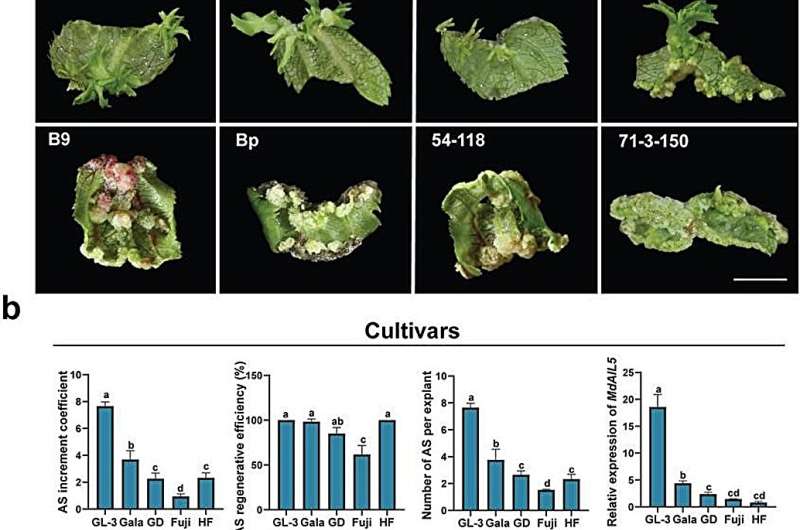This article has been reviewed according to Science X's editorial process and policies. Editors have highlighted the following attributes while ensuring the content's credibility:
fact-checked
trusted source
proofread
Enhancing apple adventitious shoot regeneration: The role of MdAIL5 in hormonal signaling and gene activation

Plants exhibit a remarkable capacity for self-repair and regeneration, a process crucial for adapting to environmental changes and underpinned by cellular totipotency or pluripotency. Apple is one of the model plants for the study of perennial woody fruit trees. The leaf disk method is mainly used to transform apples genetically, and an efficient adventitious shoot (AS) regeneration system dictates the success of this transformation.
However, the low transformation efficiency (0–3%) limited the application of transgenic and gene editing technologies in Apple. Recent studies have begun to unravel the molecular basis of regeneration, emphasizing the role of auxin and cytokinin interactions and identifying key genes that could improve regeneration efficiencies.
The complexity of hormone-based regeneration and the variability in success rates underscore the need for further research into optimizing genetic transformation methods in apples.
Horticulture Research published research titled "MdAIL5 overexpression promotes apple adventitious shoot regeneration by regulating hormone signaling and activating the expression of shoot development-related genes."
Firstly, the AS regeneration abilities of four major apple cultivars and seven apple rootstocks were assessed using a standard regenerative medium. Among the evaluated genotypes, 'Gl-3' and M26 demonstrated superior AS regeneration capabilities. Meanwhile, researchers found that MdAIL5 was most significantly upregulated during AS regeneration, and its mRNA level and AS regeneration ability were positively correlated.
Building on these insights, the study explored the function of MdAIL5. The results showed that overexpression of MdAIL5 can enhance AS regeneration efficiency in apple leaves. Notably, MdAIL5 overexpression could restore the AS formation ability of explants to a certain extent, which was lost with an increase in maturity. LC-MS/MS detection revealed that MdAIL5 overexpression increased the contents of auxin, cytokinin (CK), and other hormones in apple leaves.
Then, transcriptome analysis highlighted a range of differentially expressed genes (DEGs) associated with hormone signaling and shoot development pathways, suggesting that MdAIL5 influences AS regeneration through modulation of these critical biological processes.
Yeast one-hybrid assays, the electrophoretic mobility shift assay, and the dual-luciferase reporter assay revealed that MdAIL5 directly binds to MdARF9 and MdHB14 promoters and positively affects their expression. Further research has found that MdHB14 and MdARF9 are localized in the nucleus, and MdARF9 and MdHB14 overexpression enhances tobacco AS regeneration.
In conclusion, this research preliminarily identified the regulatory network of MdAIL5 transcription factors involved in apple leaf AS regeneration, which is beneficial for improving the efficiency of apple leaf AS regeneration and genetic transformation, laying a foundation for the validation of apple functional genes and excellent germplasm innovation.
More information: Kai Liu et al, MdAIL5 overexpression promotes apple adventitious shoot regeneration by regulating hormone signaling and activating the expression of shoot development-related genes, Horticulture Research (2023). DOI: 10.1093/hr/uhad198
Provided by NanJing Agricultural University





















